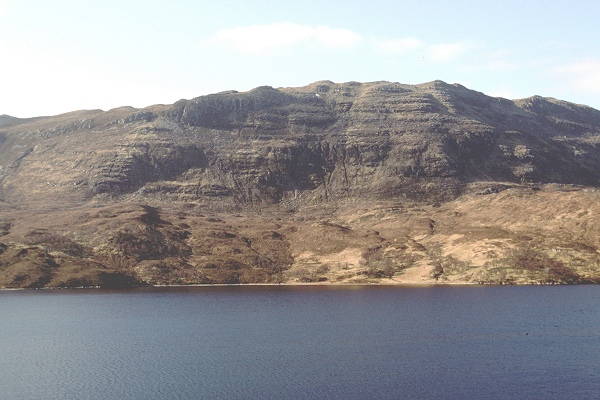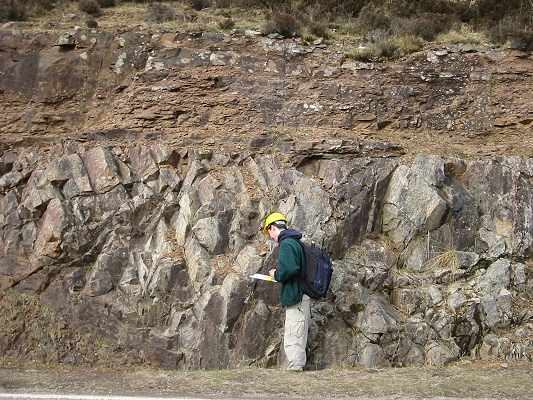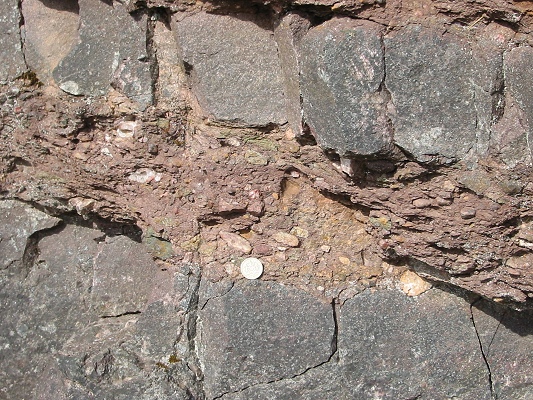
| Home | Geological History | Stratigraphy | Area map | Rock Index | About |
| Scourie | Achmelvich | Laxford | Clachtoll | Stoer | Assynt | Skiag Bridge | Glencoul | Knockan | Borralan | Ledmore |
Loch Assynt is framed by mountains made up mostly of red-brown sandstones belonging to the Torridon Group, deposited about 1000 million years ago. They were laid down by vast river systems flowing out of mountainous country that once existed to the north-west, and they buried a landscape of hills and valleys cut in the Lewisian Gneiss.

![]() View southwards across Loch Assynt towards Beinn Gharbh.
The brown hummocky ground on the lower slopes is underlain
by Lewisian gneiss, and the steep face of the mountain is
made up of horizontally-bedded Torridonian sandstones. This
view shows that the sandstones were laid down on an uneven
surface of gneiss. The contact between the sandstone and
gneiss lies at a lower level in the centre of the photo
than at the right-hand side (try following one of the lower
bands of sandstone to the right: it will meet the gneiss
"hill"). Also visible in this view is the capping of
Cambrian quartzite on the left, near the top of the ridge.
It dips gently to the east (left), cutting across the
bedding in the older Torridonian sandstones.
View southwards across Loch Assynt towards Beinn Gharbh.
The brown hummocky ground on the lower slopes is underlain
by Lewisian gneiss, and the steep face of the mountain is
made up of horizontally-bedded Torridonian sandstones. This
view shows that the sandstones were laid down on an uneven
surface of gneiss. The contact between the sandstone and
gneiss lies at a lower level in the centre of the photo
than at the right-hand side (try following one of the lower
bands of sandstone to the right: it will meet the gneiss
"hill"). Also visible in this view is the capping of
Cambrian quartzite on the left, near the top of the ridge.
It dips gently to the east (left), cutting across the
bedding in the older Torridonian sandstones.

![]() An exposure of the unconformity between flat-lying
Torridonian sandstones (above) and Lewisian gneiss with a
steeply-dipping layering (below). Angular unconformities
occur where older rocks are tilted, uplifted and eroded to
a flat surface before younger strata are laid on top of
them. In this area there is another angular unconformity in
addition to this one, because the Torridonian itself was
tilted and eroded before the deposition of the Cambrian
quartzites.
An exposure of the unconformity between flat-lying
Torridonian sandstones (above) and Lewisian gneiss with a
steeply-dipping layering (below). Angular unconformities
occur where older rocks are tilted, uplifted and eroded to
a flat surface before younger strata are laid on top of
them. In this area there is another angular unconformity in
addition to this one, because the Torridonian itself was
tilted and eroded before the deposition of the Cambrian
quartzites.

![]() Detail of coarse and pebbly Torridonian sandstones
immediately above the unconformity. The even-grained coarse
sandstone (top and bottom) is well cemented, and fractures
into angular blocks. The pebbly sandstone, however, is
relatively soft and friable, even after 1000 million years!
The coin is about 2.5 cm in diameter.
Detail of coarse and pebbly Torridonian sandstones
immediately above the unconformity. The even-grained coarse
sandstone (top and bottom) is well cemented, and fractures
into angular blocks. The pebbly sandstone, however, is
relatively soft and friable, even after 1000 million years!
The coin is about 2.5 cm in diameter.
|
Coarse feldspathic sandstone (arkose), Torridonian Loch Assynt |
| Scourie | Achmelvich | Laxford | Clachtoll | Stoer | Assynt | Skiag Bridge | Glencoul | Knockan | Borralan | Ledmore |
| Home | Geological History | Stratigraphy | Area map | Rock Index | About |
D.J. Waters, Department of Earth Sciences, May 2003